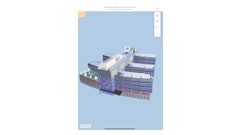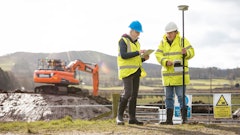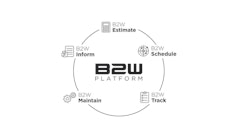
Businesses of any size with the challenge of efficiently maintaining parking surfaces can now leverage digital technology and artificial intelligence to collect the data needed to develop a pavement management plan that saves money, reduces potential liability and extends the asset’s useful life. This is good news when budgets are limited and full pavement reconstruction is rarely in the cards.
Prior to the advent of the latest technology, pavement manual condition surveys were often conducted by field workers walking around a site with measuring wheels and tablets. For example, an evaluation on an 8-acre site could take hours to collect numerous 2,500-square-foot sample areas that were then used to represent the condition of the entire paved area.
Today, workers can strap a camera on the back of their vehicle and, driving slowly, collect high-resolution imagery of an average 70 percent or more of the total paved area, versus the 10 to 20 percent that is captured doing the work manually.
The technology enables the stitching together of a mosaic image of the entire site at 2-millimeter resolution, which is then used to identify the types of pavement distress through a flaw detection model. The use of cameras mounted to vehicles is an advantage over the use of drones, which have more requirements for data collection (e.g., who can fly them and where, training, and cost of equipment). The vehicle-mounted camera equipment is inexpensive and can be deployed readily anywhere in the U.S. when a project arises.
It then all comes together using rapidly developing artificial intelligence resources that can identify pavement distress type, severity, and extent, calculating what is known as the pavement condition index, or PCI.
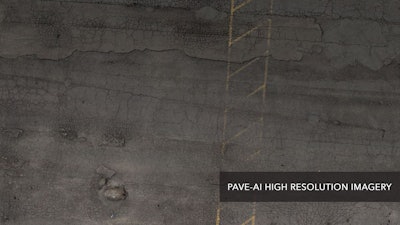
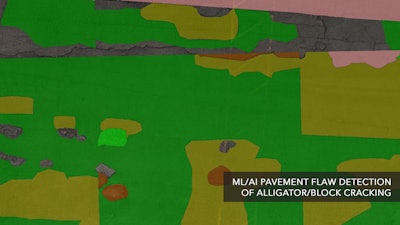
THE PCI
A PCI is a numerical index ranking from 1 to 100 of the general condition of a pavement surface. Originally developed by the U.S. Army Corps of Engineers, it has since been standardized by ASTM (an international organization that sets technical specifications) with a scale ranging from 0 – Failed to 100 – Excellent (a new pavement with no pavement distress identified).
With a PCI score, facility managers can have at their disposal unbiased, quantifiable data to prioritize and understand the condition of the pavement assets. Having PCI data equips facility managers with the information needed to determine maintenance and cost estimates for proposed pavement work. PCI scores rated high indicate the pavement is in need of only some type of preventative maintenance, while those with a low score are likely in need of a robust repair like a full reconstruction.
Pavement condition data can be stored in asset management software which is used to calculate predictions of pavement degradation and determine appropriate budgets required to maintain a pavement network at a given PCI level.
Want to maintain the full asset area at a condition level of a 75? Budget scenarios can be run to understand what it would cost to maintain at a score of 75 based on the current condition of the pavement and how it is predicted to degrade over time. The calculation is based on the types of distress on the pavement today, its original construction date, and historical maintenance. In another scenario, a decision can be made to invest very little for the next 10 years, understanding the asset’s average PCI will drop measurably. The point is that the objective PCI data gives facility managers the essential information to determine a target asset quality for the entire pavement area and to manage budget and maintenance over time to achieve it.
DATA COLLECTING AND ANALYSIS
Developing accurate PCI scores begins with breaking the site into sections – for example concrete loading docks versus asphalt parking lots – in order to generate accurate PCI segments based on similar pavement types, previous maintenance, age of construction, use, and the like. The field workers drive the area with a camera capturing the high-resolution images. Then the thousands of images are stitched into a mosaic of a complete image of the entire pavement area.
Advances in AI have allowed the development of pavement data collection programs that leverage the power of machine learning and artificial intelligence to detect the type and degree of pavement distress. That, in turn, enables the creation of visualized condition maps and tailored plans to maintain and extend the useful life of the pavement assets.
REPORTING OPTIONS
For someone responsible for managing their pavement assets, just getting the PCI scores for all of their assets is critical. Others want that plus a write-up on the condition, recommendations for maintenance and repair, a projected budget, and schedule for repair. Some request models that show how the pavement will degrade over time based on the flaws detected, cost savings and scoring if managed over time and, budget requirements as well as scoring if it is not managed.
PLANNING FOR SAVINGS
Advanced planning is a money saver. Having the data well ahead of a maintenance or repair project allows the time to plan, get bids out and make informed decisions that are free of the pressure (and higher contractor fees) typical of a rush job. Planning ahead also allows for taking weather into consideration – it’s hard to rate pavements and treat them when they are covered with snow and ice.
BARRIERS
Managers responsible for pavement management may feel they have neither the time nor the money to be proactive and can’t see how it will benefit them today. Arguments to the contrary include:
- Technology and AI speed up the data collection and provide a very robust data set and imagery of a site.
- Data is objective and makes its own case for money-saving.
- Once pavement condition data collection starts, a scalable process to preserve pavement assets can start.
- Facility managers can sit back knowing they have a plan in hand that will keep their network performing and operations up and running.
FINAL TIP
Just built a new lot? Perform a surface treatment to prevent oxidation of the asphalt. It may be brand new and performing beautifully but surface treatment on a new pavement is like putting on sunscreen. It will keep it healthy longer.






